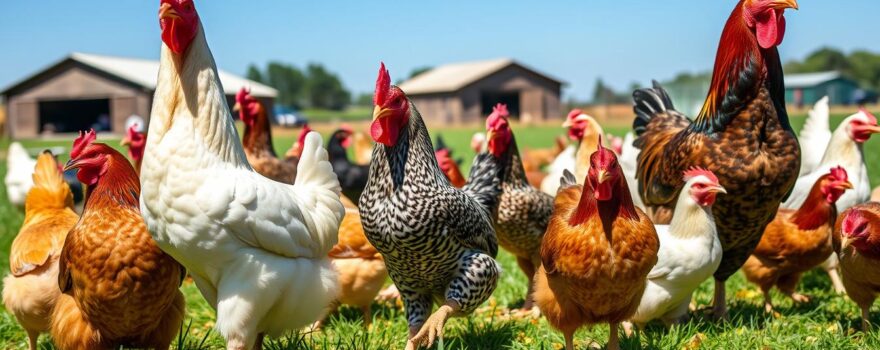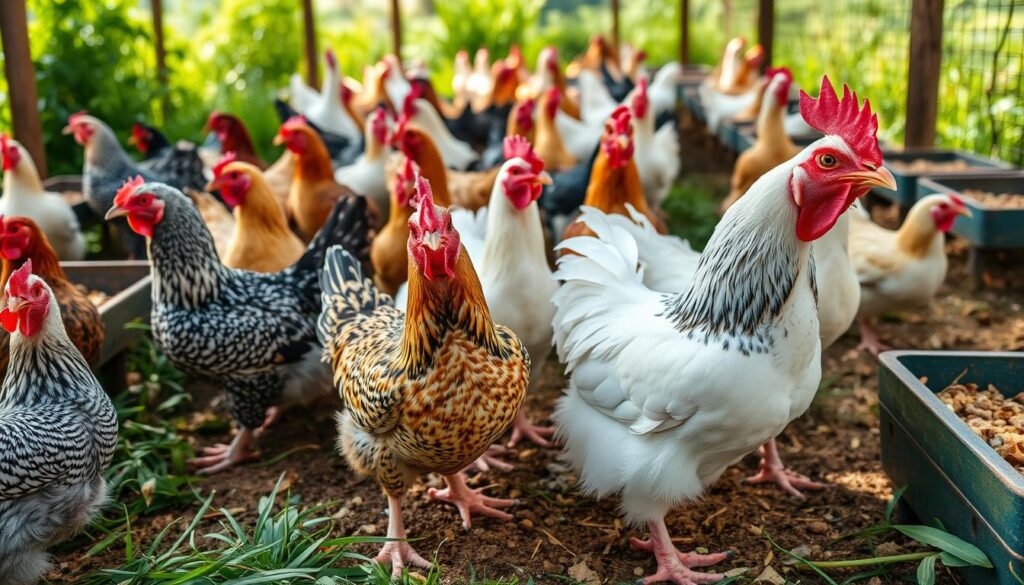
This review aims to understand the genetic changes in broiler chickens over recent decades. We’ll look at how selection for commercial goals has affected their digestive efficiency, body composition, and metabolic activity. These changes are key to improving energy use in modern broilers.
Knowing these biological changes helps us predict the poultry industry’s environmental impact. It’s crucial for the future of our planet.
Key Takeaways
- Broiler chicken growth rate has increased by over 400% between 1950 and 2005 due to advancements in genetics.
- Selective pressure has been placed on increased feed use efficiency, leading to reduced environmental impacts related to feed production and reduced nutrient emissions from poultry manure.
- Artificial selection has resulted in increased energy intake per day and metabolic heat production rate in broiler chickens.
- Energy efficiency for growth has also increased due to faster growth rates, allowing broilers to reach slaughter weight more quickly and allocate less energy to metabolic processes.
- Reduction in feed wastage and energetically expensive behaviors has been observed in broiler chickens.
Introduction to Broiler Chicken Breeds
Modern broiler chickens are key to the commercial poultry industry. They come from the red junglefowl, which has evolved a lot. This evolution is thanks to natural and artificial selection.
Evolution of Broiler Chickens through Natural and Artificial Selection
The red junglefowl adapted to different environments over billions of years. This was through natural selection. But, artificial selection in the 20th century really changed them.
Today, we see the results of Broiler Breeding Methods. Chickens now grow much faster than before. They are over 4 times heavier than those from 1950, thanks to Quantitative Genetics.
Advances in Quantitative Genetics and Commercial Application
The growth of Commercial Broiler Production is thanks to Quantitative Genetics. Breeding techniques like mass selection and hybridization have helped. They’ve made chickens more efficient and productive.

“The journey of the modern broiler chicken is a testament to the power of evolution, both natural and artificial, in shaping the most commercially successful livestock species of our time.”
Feed Intake, Digestion, and Absorption
Broiler chickens need carbs, proteins, and fats from their feed to grow and function. The type of feed affects how much they eat. This is because these nutrients are the main parts of their diet.
Choosing the right feed helps them use energy better. This is called Feed Utilization. It’s about how much energy they keep as protein and fat compared to what they need to grow.
Knowing how the Poultry Digestive System works is key. It affects how well they digest and absorb nutrients. Changes in the gut from breeding have helped them use feed better.
| Trait | Heritability Estimate |
|---|---|
| Body Weight (BW) | Moderate |
| Feed Conversion Ratio (FCR) | Moderate |
| Apparent Metabolizable Energy (AMEn) | Moderate |
| Relative Organ Weights | High |
Research shows that picking birds that eat less can be good. They might eat less, make less poop, and have less fat. But they still grow well. Traits like how well they use nutrients can be improved through breeding.
“Selection for low RFI led to decreased feed intake, excreta output, abdominal fat deposition, and increased nutrient digestibility without impacting weight gain.”

Growth Rate and Body Composition
Broiler growth rate is key to their energy use. Broilers that grow faster use less energy for other processes. This is because selective breeding has made them grow quicker.
This quick growth might change their body composition. This could affect how well they use feed.
Impact of Selective Breeding on Growth Rate
Genetic selection has greatly improved broiler growth rates. Over decades, broilers now reach market weight faster. This is thanks to advances in genetics and its use in farming.
Changes in Body Composition Due to Genetic Selection
Selective breeding has made broilers grow faster. But it has also changed their body composition. Research shows mixed results on how this affects feed efficiency.
Some studies say the increase in muscle development and carcass traits might change energy use. This could impact how well they use feed.
“The physiological growth trend of current meat broilers and dietary protein and energy management approaches for sustainable broiler production were evaluated in an Animal publication.”
More research is needed. We must understand the links between genetic selection, growth rate, and body composition. This will help us improve feed efficiency in broilers.
Metabolic Activity and Energy Utilization
It’s important to understand how broiler chickens use energy. Selective breeding has changed how they grow and use energy. This affects their feed efficiency.
Broiler chickens use energy for physical activity, growing, and keeping their bodies working. These activities are key to their energy use. They use a lot of energy for these tasks.
Keeping warm is also a big energy use for broilers. They grow fast, so they need to keep their body temperature right. This affects how much energy they need and how efficient they are with feed.
Scientists use different ways to measure energy use in broiler feed. They look at digestible energy and true metabolizable energy. The most used method is apparent metabolizable energy (AME), which takes into account nitrogen retention.
Studies show that breeding has changed broilers a lot. It has changed their body shape and how they move. Knowing this helps us make their feed more efficient and better for the environment.
“The net energy (NE) system is more comprehensive than the AME system, providing better feed efficiency according to studies.”
Looking into how broilers use energy and grow helps us improve their feed efficiency. This makes them better for farming and the environment.
Comparing Feed Efficiency Between Different Broiler Chicken Breeds
It’s important to check how well different broiler chicken breeds use feed. We use the Feed Conversion Ratio (FCR) and Residual Feed Intake (RFI) to do this. These tools help us see how each breed uses feed and grows.
Measurement of Feed Efficiency Traits
The Feed Conversion Ratio (FCR) is easy to understand. It’s the amount of feed divided by the weight gained. A lower FCR means better feed use. The Residual Feed Intake (RFI) looks at feed intake beyond what’s needed for growth and maintenance. Lower RFI values mean a broiler is more feed-efficient.
Breed Comparisons for Feed Conversion Ratio and Residual Feed Intake
Research has found big differences in FCR and RFI among breeds like Cobb, Hubbard, and Ross. For example, Cobb broilers were better in body weight, weight gain, and feed use compared to Hubbard-classic and Ross-308 (P˂0.001). Also, Cobb and Ross had better carcass and breast yield than Hubbard (P=0.016 and 0.009, respectively).
These studies help us see the genetic potential for better feed efficiency, growth rate, and carcass quality. Knowing these differences helps breeders and producers improve their operations’ performance and profits.
“Identifying suitable broiler strains and developing appropriate feed formulations for optimal performance at high altitudes is crucial, highlighting the significance of probiotic supplementation in mitigating health risks and improving survivability.”
Quantitative Assessment of Genetic Change
Researchers have studied how different breeds use energy to understand the genetic changes in broiler energy efficiency. They looked at how energy is used for growth and heat. Over the years, broilers have grown faster and used less food, showing big improvements.
Estimating Metabolizable Energy Intake and Distribution
Today’s broilers eat more metabolizable energy than before, helping them grow quickly. This energy is split between energy partitioning for growth and metabolic heat production. Knowing how they use energy helps us see how they’ve gotten better at using feed.
Role of Feed Formulation in Improving Feed Efficiency
Changes in feed formulation have also helped broilers use feed better. These changes include more energy density and amino acid content. By tweaking the diet composition, researchers have boosted growth and nutrient utilization. This has made broilers more efficient at using feed.
“Genetics and breeding account for approximately 80 to 90% of production improvements in the broiler industry observed today.”
- In the last 60 years, the poultry industry has made huge strides in genetics. Growth rates have soared by over 400%, and feed use has dropped by 50% in broiler chickens.
- Researchers have also worked on layer chickens. They’ve focused on feed efficiency and immune response. This helps us understand how better feed use affects health.
- By 2034, broilers are expected to reach 2.34 kg (5 lb) in less than 29 days. This shows the ongoing genetic improvement.
Environmental Impact Implications
The poultry industry’s big environmental problem is making feed. This feed makes up 65% to 80% of greenhouse gas emissions and energy use. Making broiler chickens more efficient in eating feed is key to reducing environmental harm.
Reducing Environmental Footprint through Improved Feed Efficiency
In the last 30 years, breeding has made broilers grow faster and eat less. Now, at 35 days, they weigh 2.44 kg and eat 3.66 kg of feed. This progress has cut down the industry’s environmental harm, like methane and nitrous oxide emissions.
More work on making broilers eat better can help even more. Traits like feed conversion ratio (FCR) and residual feed intake (RFI) show there’s room for improvement. Research into these areas could lead to big gains in poultry sustainability.
“Improving the feed efficiency of broilers through genetic and nutritional advancements can significantly reduce the environmental footprint of chicken production, making it a key focus for the industry.”
Genomic Regions and Candidate Genes
Genome-wide association studies (GWAS) have found several genomic regions and candidate genes linked to feed efficiency in chickens. These discoveries offer insights into the genetics of feed efficiency. They help guide future breeding efforts to enhance this key trait.
Genome-Wide Association Studies for Feed Efficiency Traits
Recent studies have uncovered the complex genetics of feed efficiency in broiler chickens. The genetic influence on growth and feed efficiency in Wenchang chickens is moderate to strong. This is shown by genomic heritability estimates ranging from 0.30 to 0.44.
Researchers have pinpointed several candidate genes involved in feed efficiency. These include PLCE1, LAP3, MED28, QDPR, LDB2, and SEL1L3. These genes are linked to mitochondrial function and behavior. They can affect how chickens use feed and grow.
| Trait | Genomic Heritability Estimate |
|---|---|
| Body Weight at 28 days (BW28) | 0.30 |
| Body Weight at 42 days (BW42) | 0.44 |
| Residual Feed Intake (RFI) | 0.37 |
| RFI Adjusted for Abdominal Fat (RFIa) | 0.34 |
The study found several genome-wide significant single nucleotide polymorphisms (SNPs) linked to growth and feed efficiency. These SNPs are near the candidate genes. This supports their role in regulating feed efficiency in broiler chickens.
“Identifying the genetic factors underlying feed efficiency is crucial for developing effective breeding strategies to improve this economically important trait in the poultry industry.”
This review looked at how artificial selection affects broiler chickens’ feed efficiency. It found that while growth and feed use have improved, many factors play a role. These include Broiler Feed Efficiency, Genetics, Nutrition, and the environment.
Studies have shown that high amino acid diets help broilers grow faster and use less feed. Also, multiple feeding phases can improve weight gain and feed use in the early stages. But, the results of these methods vary from study to study.
In the future, research and innovation will be key for the poultry industry. They aim to boost Broiler Feed Efficiency and lessen environmental harm. The industry can create more efficient and green boiler systems by studying how Genetics and Nutrition interact. This will help meet the world’s increasing demand for quality poultry.